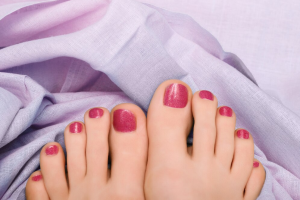Is Laser Treatment the Future of Fungal Nail Care?

Onychomycosis, or fungal nail infection, is a widespread medical condition that affects millions of people globally. Discolored, thickened nails that may produce pain represent the common infection symptoms that substantially reduce daily functionality for those affected.
Fungal nail infections do not increase risks to life, but they still create both physical pain and damage to one’s self-esteem, making simple activities like walking or wearing shoes challenging. The standard treatment for onychomycosis typically involves antifungal medications taken orally or applied topically, along with surgical intervention for more severe cases.
These medical interventions take time to show results and can lead to unwanted side effects. However, the medical field introduced laser therapy as a promising innovative treatment that addresses the persistent nature of this medical challenge because of known therapy limitations.
As laser treatment gains traction, it raises questions about whether the technology represents future fungal nail treatments or if dermatology and podiatry breakthroughs may replace it. This article examines the long-term therapeutic possibilities of laser treatment for fungal nail infections while assessing its role in upcoming nail care developments.
What are Fungal Nail Infections?
Fungal nail infections usually occur when fungi infect nail beds through dermatophyte yeast or mold infections, which take residence in finger or toe skin tissues.
These infections thrive in warm, moist environments and are most common in people with diabetes, poor circulation, immune deficiencies, or excessive perspiration, particularly in damp areas like swimming pools or locker rooms.
Symptoms of a fungal nail infection range from mild to severe, including nail discoloration (yellow, white, or brown), thickening, crumbling edges, unpleasant odor, and discomfort. The infection becomes more severe if left untreated, causing extensive nail damage and pain while walking, which can eventually lead to nail loss.
Treatment of fungal nail infections proves challenging because patients need antifungal drugs for several months or must undergo repetitive, intrusive procedures. Experts have begun using fungal nail laser treatment as an alternative to traditional treatments due to its faster results and minimal side effects.
The Emergence of Laser Treatment for Fungal Nails
Medical studies indicate that laser treatment of fungal nails recently became popular due to its ability to directly target the underlying fungal infection. Laser treatment targets the fungal infection within the nail bed while leaving surrounding healthy tissue unharmed.
This characteristic makes laser therapy a more targeted and potentially more effective treatment for onychomycosis. There are three types of lasers that are usually used for fungal nail treatment, including:
1. Lunula Laser
Lunula Laser delivers non-thermal low-level laser therapy (LLLT) for treating infection while avoiding heat production to activate natural healing mechanisms. During Lunula Laser treatment, the system produces dual light wavelengths, eliminating fungi and stimulating tissue recovery.
The blue light in Lunula Laser destroys fungal organisms that cause infections, while the red light helps tissue repair and enhances nail growth. This laser delivers no side effects because it uses non-thermal technology that maintains skin gentleness.
Its treatment sessions last 12 to 15 minutes without any post-procedure recovery period.
2. Nd:YAG Laser
Nd:YAG Laser is the primary laser instrument used to treat fungal nail infections. The treatment uses light waves at a specific wavelength that penetrate the nail and get absorbed into the infected tissue.
During treatment with the Nd:YAG Laser, the generated heat eliminates fungus cells while leaving the surrounding healthy tissue unaffected.
3. Fractional CO2 Laser
Fractional CO2 Laser is sometimes used to treat fungal nails, particularly in severe cases, but it is less common than the Nd:YAG Laser. The laser makes micro-injuries in the nails and adjacent tissues to enhance the penetration of antifungal medication. Severe cases of onychomycosis usually require treatment with this method.
Both lasers target the fungus precisely without obligating patients to take systemic medication or perform physical nail extractions.
This treatment method provides patients with a non-invasive procedure that requires brief recovery time because it is an attractive alternative for those unresponsive to conventional treatment plans.
How Does Laser Treatment Work?
The process of treating fungal nail infections through laser treatment includes the following sequence:
-
Preparation
Patients need to get their nails cleaned during the initial stage, followed by preparation work. To better penetrate the laser, the clinician performs minimal nail filing.
-
Laser Application
Medical staff will activate the laser device to apply to the infected nails. The length of laser treatment sessions depends on how many nails need therapy alongside the disease severity.
The patient will experience a minor sensation of warmth and tingling during laser treatment when the laser works to destroy the infection.
·Post-Treatment Care
The patient gains permission to resume regular activities upon completing the treatment session. After the procedure, minor inflammation and redness in the treatment zone are common but resolve entirely within a few hours.
· Follow-Up
Multiple laser procedures are performed to successfully eliminate the fungal infection from recurring. Patients might require periodic follow-up treatments to prevent recurrence after their initial series of treatments.
Is Laser Treatment Effective?
According to lab research and daily medical use, fungal nail infections receive successful treatment through lasers. Scientific research proves that laser treatment results in dramatic nail appearance improvements, symptom reduction, and total infection elimination in particular situations.

Advantages of Laser Treatment
There are several advantages of laser treatment over traditional treatments for fungal nail infections:
-
Non-Invasive
Laser treatment does not require any cutting or nail extraction procedures. It provides patients with a treatment alternative that causes negligible pain and offers better comfort than both surgical procedures and prolonged oral antifungal drug utilization.
· Faster Results
The duration of a standard fungal treatment is months, but laser methods produce quicker therapy and recovery outcomes. Patients generally see results after a few weeks of treatment, with the complete benefits becoming apparent throughout three months.
· Targeted Treatment
Laser therapy allows precise penetration through the nail to target the infection deep beneath the surface, offering better results than topical medications, which often struggle to reach the infection.
Is Laser Treatment the Future of Fungal Nail Care?
The medical fields of dermatology and podiatry have experienced significant progress in the treatment of fungal nails with lasers. Research developments in laser therapy bring better efficiency and broader availability of laser treatments.
Laser therapy has the potential to assume a leading position in the upcoming treatments for fungal nails through its capability to deliver fast and effective treatment with minimal invasiveness compared to traditional methods for managing onychomycosis.
Conclusion
Laser treatment represents a significant advancement in the treatment of onychomycosis. The continuous technological progress creates opportunities for laser therapy to establish itself as a standard medical approach, thus transforming fungal nail treatment strategies.
This treatment’s non-invasive procedure is better than conventional fungal nail infection therapy because of its outstanding results, minimal impact, and easy application. The treatment provides groundbreaking options to patients who need immediate yet reliable and enduring remedies.
Future approaches to managing fungal nail infections will likely favor laser therapy as ongoing technological advancements make it an increasingly preferred solution. People who fail to see improvement from standard fungus treatments should consider laser medicine as a hopeful option to obtain the treatment results they require.






